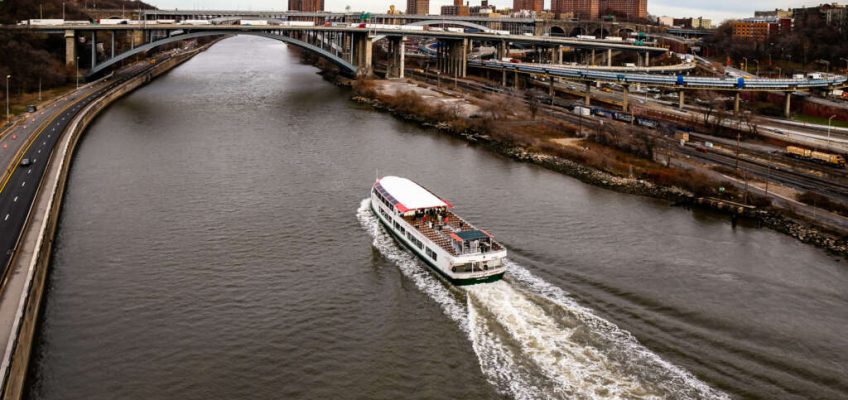The state proposes giving the Harlem River a new classification that would exempt the city from meeting bacterial water quality standards when it rains—and environmental groups are not happy about it.
The Harlem River, which runs between Manhattan and the Bronx, sees more overflow from the sewer system than any river in the state, according to the non-profit Swim Coalition. (Photo by Adi Talwar)
The Bronx’s environmental community is standing strong against a state proposal to assign the Harlem River a new water quality classification that would exempt the city from meeting clean-water safety standards during rain events.
The Harlem River, a waterway that connects the Hudson and East rivers, receives 1.9 billion gallons of raw sewage and polluted stormwater from the city’s overloaded sewer system, known as Combined Sewer Overflow (CSO), annually. That’s an average of 5 million gallons per day.
“The Harlem River is not a dumping ground—it is a vital waterway and a source of pride and recreation for the Bronx. Any proposal that weakens protections for our river is an affront to the health, dignity, and future of our community,” said Congressman and Bronx-native, Ritchie Torres, at a press conference on Tuesday.
The State Department of Environmental Conservation (DEC) put out a proposal in mid-April to give the Harlem River an “SB Wet Weather” classification.
The move is part of a larger effort to update the water quality criteria of bodies of water across the state, and the Harlem River is the first up for discussion. The public is now invited to weigh in on the proposal and has until June 26 to submit comments. The DEC has until April of next year to make a final decision on the river’s future status.
But environmental groups say the classification proposed for the Harlem River would allow the city to relax water quality standards for bacteria found in the waterway up to 36 hours after wet weather events.
“The SB Wet Weather classification is a cop-out because then the city gets to say: we actually don’t have to spend any more money on improving water quality in the Harlem River, since we are already meeting this lower standard,” said Em Ruby, advocacy and policy coordinator at the environmental group Riverkeeper.
Lifting water quality standards when it rains is problematic because rainfall is what drives the river’s CSO problem in the first place, experts say.
CSO pollution happens because the city’s archaic sewer system can’t handle the amount of water that comes in during a downpour. The pipes overflow and end up dumping untreated sewage into nearby waterways.
With a total of 65 CSO outfalls feeding into its waters, the Harlem River receives the most combined sewage overflow out of any river in the state, according to the non-profit Swim Coalition.
Environmental advocates want the “wet weather” exemption to be dropped. Instead they propose an “SB classification“—which says the water must be clean enough to swim and fish in—ultimately pressuring the city to clean up the river to meet that higher standard.
“If that were to happen, the state would set the goal for New York City to ensure that the Harlem River has water quality that is safe for swimming 100 percent of the time, regardless of whether it rains or not,” Ruby explained.
The Inwood waterfront, Harlem River side, seen from the Bronx. (Photo by Adi Talwar)
But the DEC noted in email that although the SB Wet Weather classification includes an exemption for rain events, it’s an upgrade from the river’s current Class I status. This denomination means the city only needs to keep the water clean enough to allow for secondary contact recreation, like boating and fishing.
By upgrading the water quality classifications for rivers across the state, the DEC said in an email that it’s “making generational investments and improvements in protecting water quality and public health for future generations.”
“These landmark regulatory changes are unprecedented, building upon decades of ongoing progress to transform the Harlem River and other waters in and around New York City,” the Department added.
The DEC also defends the wet weather exemption in its proposal for the new classification, arguing that it would cost $9.3 billion dollars to build and replace new infrastructure that captures 100 percent of the CSO feeding into the Harlem River.
“It’s too costly. We understand why that’s impossible,” said Robert Fanuzzi, board member of the Bronx Council for Environmental Quality.
Instead, Fanuzzi and other environmentalists want the city to scale up alternatives. That means investing further in ongoing efforts to add rain gardens and green infrastructure to rooftops, so they absorb rainwater before it makes its way into the sewers and triggers an overflow.
There are also gray infrastructure projects that can capture CSO at strategic points where overflow happens often, holding the sewage during a downpour so it can be redirected for treatment after a storm is over.
New York City has already vowed to end the discharge of untreated sewage into the New York Harbor by 2060. Setting a higher standard now will push the city to invest in alternative infrastructure that tackles this city-wide problem, advocates say.
“The city should be working with community members to make sure they have access to the water and that it’s clean enough for swimming and fishing,” said Chauncy Young, coordinator at the Harlem River Coalition. And those efforts should be concentrated in the communities where pollution is at its worst, Young notes.
“The Hudson River is swimmable and fishable. Why is the Harlem River not?”
To reach the reporter behind this story, contact Mariana@citylimits.org. The reach the editor, contact Jeanmarie@citylimits.org
Want to republish this story? Find City Limits’ reprint policy here.
The post Harlem River Status Change Could Stall Cleanup Efforts, Environmentalists Warn appeared first on City Limits.


Leave a Reply